| Jiangjunding Formation | |
|---|---|
| Stratigraphic range: Campanian-Maastrichtian ~ | |
| Type | Group |
| Unit of | Wangshi Group |
| Underlies | Jingangkou Formationn |
| Overlies | Hongtuya Formation |
| Lithology | |
| Primary | Conglomerate, sandstone, siltstone |
| Other | Marl |
| Location | |
| Coordinates | 36°54′N 120°42′E / 36.9°N 120.7°E |
| Approximate paleocoordinates | 37°18′N 111°00′E / 37.3°N 111.0°E |
| Region | Shandong |
| Country | |
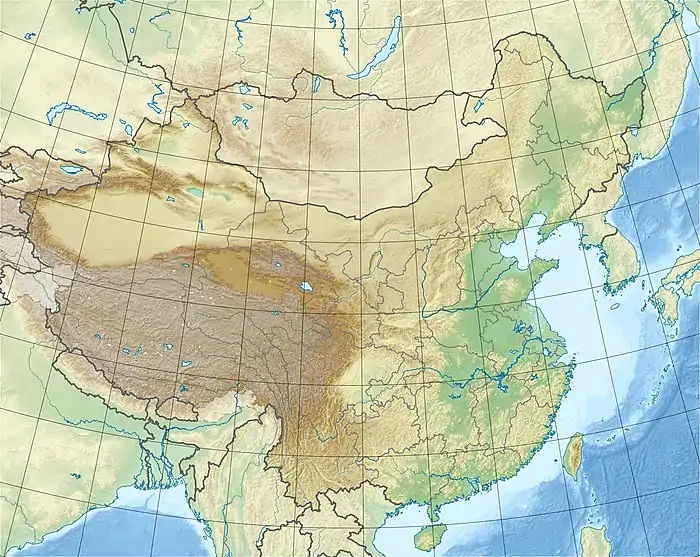 Jiangjunding Formation (China) 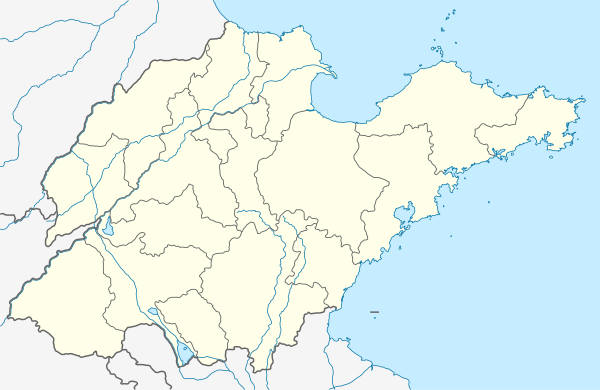 Jiangjunding Formation (Shandong) | |
The Jiangjunding Formation is a geological formation in Shandong, China whose strata date back to the Campanian-Maastrichtian stages of the Late Cretaceous.[1] Dinosaur remains are among the fossils that have been recovered from the group.[2]
The Jiangjunding formation consists purpley-grey or reddy-brown sandstones or various consistencies, siltstones and conglomerates. The Jiangjunding Formation was deposited in a fluvial to lacustrine environment. The climate was warm and humid during the majority of the timespan, although it was beginning to dry out after the Jiangjunding.[3]
Paleofauna
Dinosaur eggs are known from this formation.[4]
| Paleofauna of the Jiangjunding Formation | ||||||
|---|---|---|---|---|---|---|
| Genus | Species | Location | Stratigraphic position | Material | Notes | Images |
| Cheloniidae aff. Nanhsiungchelyidae[5] | Indeterminate[6] | |||||
| Coelurosauria indet.[5] | Indeterminate[6] | |||||
| Micropachycephalosaurus[7] | M. hongtuyanensis[7] | "Partial mandible, associated postcranial fragments."[5] | 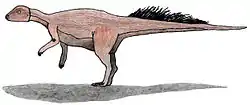 | |||
| Pinacosaurus[8] | P. cf. grangeri[8] |  | ||||
| Sauropoda indet.[5] | Indeterminate[5] | |||||
| Shantungosaurus[6] | S. giganteus[6] | Xingezhuang Formation | 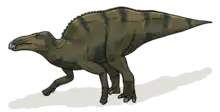 | |||
| Tanius[6] | T. sinensis[6] | 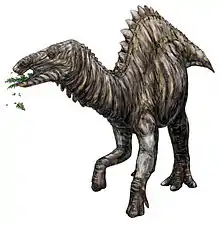 | ||||
Age of the formation
The Wangshi group of geologic formations is generally considered to be from the Late Cretaceous, although some regions are older. Based on the discovery of Pinacosaurus, only known elsewhere in the Djadokhta Formation or regions of the same age, the Wangshi Group was presumed to be a similar age of 75–71 million years old. The specific age for the Hongtuya Formation has been identified as 73.5–72.9 mya. As the Hongtuya is directly older than the Jiangjunding, it was identified that the Jiangjunding must be of latest Campanian to earliest Maastrichtian age, according to Borinder (2015).[3]
References
- ↑ Wangshi Group in the Paleobiology Database
- ↑ Weishampel et al., 2004, pp.593–600
- 1 2 Borinder, N.H. (2015). Postcranial Anatomy of Tanius Sinensis Wiman, 1929 (Dinosauria; Hadrosauroidea) (PDF) (Report). Examensarbete vid Institutionen för geovetenskaper. Uppsala University. ISSN 1650-6553.
- ↑ Zhang, J.L.; Wang, Q; Jiang, S.X.; Cheng, X.; Li, N.; Qiu, R.; Zhang, X.J.; Wang, X.L. (2017). "Review of historical and current research on the Late Cretaceous dinosaurs and dinosaur eggs from Laiyang, Shandong" (PDF). Vertebrata PalAsiatica. 55 (2): 187–200.
- 1 2 3 4 5 "Table 21.1," in Weishampel, et al. (2004). Page 466.
- 1 2 3 4 5 6 "48.9 Shandong, People's Republic of China; 1. Wangshi Group," in Weishampel, et al. (2004). Page 598.
- 1 2 Z. Dong. (1978). [A new genus of Pachycephalosauria from Laiyang, Shantung]. Vertebrata PalAsiatica 16(4):225–228.
- 1 2 Listed as "Pinacosaurus cf. grangeri" in "48.9 Shandong, People's Republic of China; 1. Wangshi Group," in Weishampel, et al. (2004). Page 598.